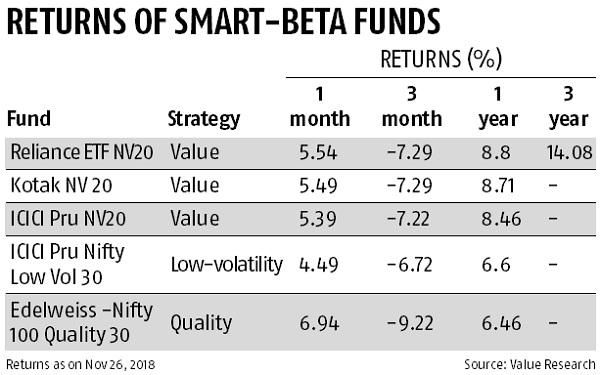'Investors should allocate about 5% to 10% to such funds.'
Tinesh Bhasin finds out more.

Popular in developed markets, Indian fund houses are now increasingly looking at smart-beta funds.
These low-cost schemes replicate indices that are designed based on different investing strategies such as value, low volatility, etc.
SBI Mutual Fund recently launched the SBI-ETF Quality. The exchange-traded fund replicates Nifty200 Quality 30 Index, which comprises the top 30 companies based on return on equity (RoE), financial leverage (debt-to-equity ratio), and their earnings growth.
Every fund manager tries to select the best quality stocks and invest in them, but it's finally based on their judgement.
"The SBI-ETF Quality does the same without any human invention. The Nifty200 Quality 30 Index comprises the best quality companies based on a formula. Our fund will replicate it, and there will be no fund manager's judgment involved," says Navneet Munot, chief investment officer, SBI Mutual Fund.
While smart-beta funds -- also known as rule-based or multi-factor funds -- are not popular in India, they have been doing well lately.
While the one-year return from most equity fund categories are in red, value funds based on smart beta strategy have returns of over 8%.
These funds invest in select 20 firms that are part of the Nifty 50 index.
The one-year returns from Reliance ETF NV20, Kotak NV20 ETF and ICICI Prudential NV20 ETF were 8.8%, 8.71% and 8.46%.
"When markets were doing well, it did not do that well. When markets rise, it's the momentum stocks that do well. But when markets are falling, volatile or sideways, value investing works well, which explains the returns from these funds," says Kaustubh Belapurkar, director (fund research), Morningstar Investment Adviser India.
In fact, one-year returns from other smart-beta funds have also been far ahead of other schemes.
ICICI Prudential Nifty Low Vol 30 ETF's one-year return is at 6.6% and Edelweiss ETF-Nifty 100 Quality 30 is at 6.46%.
"Smart-beta funds add diversification of strategy to a portfolio.
"They are semi-active -- they have stock selection criteria but replicate an index passively. Investors should allocate a small portion -- about 5% to 10% -- to such funds," says Belapurkar.
Smart-beta funds are also low-cost.
Their costs are now as low as an index fund but not as high as an actively managed fund.
The expense ratio is between the two.
Experts feel that while they add diversification to the portfolio, they may not be able to outperform actively-managed funds in the long term.
"In developed countries, the markets are efficient. In India, fund managers can still spot stocks that offer high returns," says Vidya Bala, head of mutual fund research, Fundsindia.com.
But Bala cautions that these funds don't have a long-term track record.
One way to evaluate such funds is to see if there are corresponding actively-managed funds.
In case of SBI-ETF Quality, for example, Bala suggests one can look at its performance vis-a-vis SBI Multi Cap Fund.
Also ensure there's liquidity in ETFs before you invest.
Many investors are stuck with ETFs on lack of liquidity.
When selling the stock, they are offered lower value than the existing net asset value.













 © 2025
© 2025